(Updated: 03/29/07)
Analyzing the smoke plume in Val's photo
When observing the smoke plume in the photo, it looks like a classic short pulse explosion normally seen from an ordnance blast with a thin column at its base and is more grey in color. Also, it looks like the plume is still in its infancy stage because it looks like it's still rising straight up and doesn't look at all dissipated by the reported 9 knot wind in the area.
The plume still being in its infancy stage and looking like it has drifted yet is consistent with Val claiming that her photo was timed out to have been taken approx. 5 seconds after impact. The FBI are saying it was taken within seconds after impact and this time frame is what the Ambassadors are telling visitors at the Flight 93 Memorial too:
***See also: Val's plume vs. WTC 2 explosion plume***
Analyzing the smoke plume in Val's photo
When observing the smoke plume in the photo, it looks like a classic short pulse explosion normally seen from an ordnance blast with a thin column at its base and is more grey in color. Also, it looks like the plume is still in its infancy stage because it looks like it's still rising straight up and doesn't look at all dissipated by the reported 9 knot wind in the area.
(Photo source: Pittsburg Post-Gazette. See also ordnance comparison photo below.)
The plume still being in its infancy stage and looking like it has drifted yet is consistent with Val claiming that her photo was timed out to have been taken approx. 5 seconds after impact. The FBI are saying it was taken within seconds after impact and this time frame is what the Ambassadors are telling visitors at the Flight 93 Memorial too:
"This cloud picture was taken from a mile away within seconds of the crash. The FBI says that had to be within a couple of seconds because the wind immediately moved the cloud east toward Bedford and all this debris kept falling out it as it went, so they had to send people tracking it -- climbing on rooftops and treetops, through fields..."
The claim of Val's photo being taken approx. 5 seconds after impact seems impossible. Val claims that she was almost knocked off her couch from the explosion, however the soundwave of the explosion would take approx. 8 seconds to reached her house approx. 1.6 miles from the crater (or 8,438ft). By this account, Val took her photo 3 seconds before the soundwave reached her house!
It's also questionable that Val could even have taken a photo in 5 seconds after jumping up off her couch, running to her door, grab her camera, find the button on her camera to turn it on, wait briefly until the camera warms up and is ready to shoot, go out on her porch, and aim her camera to take that perfect shot. In order for the offical story to be true, the shockwave from the impact that allegedly jolted her on her couch had to reach her house that is 1.6 miles away almost instantly and Val did all the above within 5 seconds.
The Plume
A smoke plume from a jet fuel fire is usually very dark in color and usually has a thick continuous column of smoke coming up from the ground (depending how much fuel it still had at impact) from all the un-burnt fuel and other burning debris when it's still in its "mushroom" stage:
It should be noted that a plane crash did leave a rare smoke cloud formation similar to Val's plume:

The plume on the left came from a L-100-30 Hercules crashing in Italy after making a long high speed decent. However there are a few things to note about this plane crash plume and some points actually help the fraud claims against Val's photo:
- It's very rare that a plane crash makes this kind of plume formation.
- It is unknown how much fuel was on board at impact. The pilots could have emptied out most/all of the fuel on board as they knew they were about to crash.
- The photo of this plume looks to be taken within seconds of the crash just like Val's was alleged to since the plume looks like it is still going straight up, it is not that high off the ground, and doesn't look very dissapated (this point will be very important later on in this article).
- This plane crash left large debris of itself unlike Flight 93's alleged crash.
Here are the dimensions of a Boeing 757:

Basic Dimensions
Wing span - 124 ft 10 in (38.05 m)
Overall Length - 155 ft 3 in (47.32 m)
Tail Height - 44 ft 6 in (13.6 m)
Body Exterior Width - 12 ft 4 in (3.7 m)
(Source: Boeing)
Wing span - 124 ft 10 in (38.05 m)
Overall Length - 155 ft 3 in (47.32 m)
Tail Height - 44 ft 6 in (13.6 m)
Body Exterior Width - 12 ft 4 in (3.7 m)
(Source: Boeing)
Here is how we were told Flight 93 crashed:

(Graphic found here.)
Flight 93
Crashed:Shanksville , PA
Crashed into: old strip-mine that was recently backfilled and burrowed itself underground
Angle of crash: 40 deg (alleged Flight Data Recorder); 90 deg (eye witnesses)
Time of impact:10:03:11
Speed @ impact: 580 mph
Fuel @ impact: 5,500 gal (37,500 lb)
Crashed:
Crashed into: old strip-mine that was recently backfilled and burrowed itself underground
Angle of crash: 40 deg (alleged Flight Data Recorder); 90 deg (eye witnesses)
Time of impact:
Speed @ impact: 580 mph
Fuel @ impact: 5,500 gal (37,500 lb)
(Link)
Notice that the grass around the crater and even growing right up to it is not burnt which shows that none of the 5,500 gallons of fuel on board at the time of impact splashed on the grass and caught fire when the plane burrowed underground:

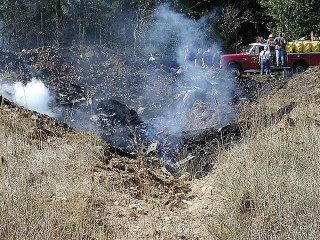
Notice that the only thing that is burnt, other than inside the crater, is a section of forest at an odd trajectory. It's like yourself running into a wall and your guts flying out of your right side only and not only that, but your guts fly up and over the street into the neighbors yard without hitting the street:
Rumpl4skn shows us that the plume in Val's photo does not line up over the crater:
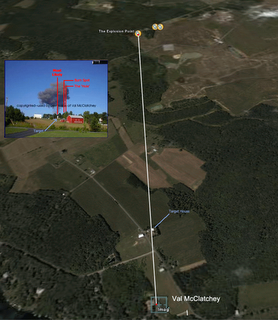 (Click photo for hi-res. Photo mirror.)
(Click photo for hi-res. Photo mirror.)(Click photo for hi-res. Photo mirror. Source for his pics.)
I concur with Rumpl4skn that the trajectory of the smoke plume lines up away from the crater and right next to the pond where a fuselage piece from Flight 93 was reportedly found:
Rumpl4skn then shows that if the plume originated from the crater, it would take approx. 50 seconds to drift approx. 250 yards south into Val's camera direction from the reported 9 knots wind in the area. Remember it was approx. 13 seconds from when Val felt the blast and ran out to take her photo.
The next batch of comments concerns the issue that - if the smoke cloud was a believable size (which it is not), could it have drifted into position where Val snapped the picture? I.e., could it have originated at the hole, and the prevailing 9 knot wind that morning (Nat. Weather Svc.) blew it into alignment with her camera angle?
For background, consider Val's story, in which she details that she took this shot (the only shot she took, btw) within "5 seconds" of hearing the blast, and rushing out her door, camera in hand.
A 756' [252yrd/230m] drift at 15.19 feet/second (9 knots) would have taken closer to 50 seconds to complete. So, this is another problem with either the hole, the cloud, or Val's schtick.
I know this is approaching overkill now, but we're dealing with some people who are determined to prove my analysis incorrect. However, not quite as determined as I am to prove that it's factual. - Rumpl4skn
We have shown that the plume in Val's photo could not have originated from the crater if Val really did take her photo "approx. 5" after feeling the blast and for the blast taking approx. 8 to reach Val. The plume would have originated right next to the pond which is approx 275 yards from the crater.
Next we will show you that not only did the plume in Val's photo not originate from the crater, but the plume in her photo is way too big to have even originated by the pond approx. 275 yards from the crater and realistically could have only originated just beyond the horizon in her photo.
This first photo is a close-up of Val's house and the red barn and white barn. The yellow line shows the direction that her camera was pointing and the grey lines show the width of the plume (black lines in her photo):
 (Photo scale at 100 ft/50 m. Click photo for hi-res. Photo mirror.)
(Photo scale at 100 ft/50 m. Click photo for hi-res. Photo mirror.)(Satellite photos of the area taken from Google Maps. All photos are in standard navigational directions; North = top, South = bottom, East = right, West = left)
 (Close up detail of Val's house by Rumpl4skn.)
(Close up detail of Val's house by Rumpl4skn.) (Val's front porch. Photo source: Windsor Park Stories)
(Val's front porch. Photo source: Windsor Park Stories)This second photo continues to show the trajectory of her camera direction and the width of the smoke plume on her photo:
On this last photo analysis, I included two equally sized explosions (orange) that I generously estimated that would have come from the crash scene area (based from the distance from the crater to the outer most part of the burnt forest section) and I inserted one where it first meets the two plume width lines (grey lines). You can clearly see that the explosion cloud in Val's photo could not have been anywhere near the crash scene, but only much closer to her house:
(Photo shows a possible location of where the ordnance blast took place. Credit to Rumpl4skn. Click photo for hi-res. Photo mirror.)



(600ft = 200yd/183m; 2,200ft = 733yd/671m; 100yd = 1 football field)

Also note the the crater sits well below the horizon in Val's photo, so the plume would have had to risen that much more before it is even seen over the horizon to be seen from Val's vantage point.
(See also plume comparison. Diagrams and animated gif by Rumpl4skn. Click photos for hi-res. Mirrors: top photo, middle photo.)
(See also plume comparison. Diagrams and animated gif by Rumpl4skn. Click photos for hi-res. Mirrors: top photo, middle photo.)
While I stand by my calculations (due to the precise locational parameters of having her porch rain gutter in the uncropped photo) let's assume she wasn't where I say she was. Here is where Val would have to have been standing in order for her smoke plume to align with the "hole" (over 50 yards to the East, behind a tree line and a small garage or shed on the other side of the road):
In other words, a few inches, feet or even yards is not a believable margin of error. Val's location could not be imprecise enough to adjust the smoke plume to where it should be, to confirm the govt's story, and validate the "hole" as the crash site. - Rumpl4skn
Below I superimposed three Heinz Stadiums (home of the Pittsburgh Steelers) at the same scale with the satellite photo back to back to help give more of a perspective of how wide Val’s plume would have been if it originated near the crater (green arrow):
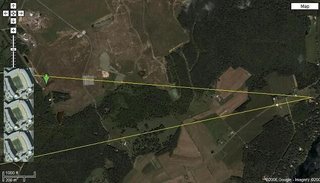
Remember the wingspan of a Boeing 757 is about 125ft wide, not even the length of a football field's 50-yard line which is 150ft long.
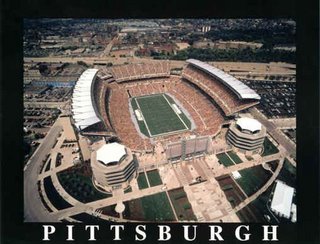








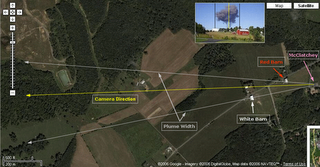




2 comments:
You've made two mistakes in your analysis.
First, the angle of the wind in this photo is wrong:
http://photos1.blogger.com/blogger/7508/1605/320/plume-drift.png
You have it crossing the path of camera trajectory at almost a 90 degree angle.
If you look at this photo
http://photos1.blogger.com/blogger/7508/1605/320/pm-map-flight-paths.png
it shows the proper relationship between the direction of the wind and the trajectory of the camera. The two vectors are off by less than 45 degrees.
This means that the wind would be blowing the plume more in the direction of the camera than you account for.
Your next error has to do with the wind speed. The speed was around 10mph, but that's a ground wind speed. Wind speed increases as altitude increases. That's why they build those windmills on top of large hills and build them as tall as the cost effectively can.
So, as the explosion plume blew upward, the wind speed increased, and therefore blew the plume closer to the camera.
That also explains how light debris got into Indian Lake.
If the wind was blowing the plume more in the direction of her house, then that means the plume must have travelled even further than the minimum 756' in order to reach the camera trajectory.
But sticking with the 756' minimum, some simple maths shows that the wind require to move the plume 756' in 13 seconds is 34.4 knots. That's a gale force wind!!
But there were no gale force winds that day - see http://www.wunderground.com/history/airport/KJST/2001/9/11/DailyHistory.html?req_city=NA&req_state=NA&req_statename=NA
So, even when being as generous as possible to the official story, the figures do just not add up. It's hard to believe that plume was from the suggested plane crash at the suggested location.
PS - The maths:
1. Minimum distance the plume must have moved = 756' = 1/7 mile.
2. Time it took plume to reach move = how long it took photographer to hear the sound + response time = 8 seconds + 5 seconds = 13 seconds = 1/277 hour.
3. Require movement speed of plume = (1/7) / (1/277) = 39.65 miles/hour = 34.45 knots.
Post a Comment